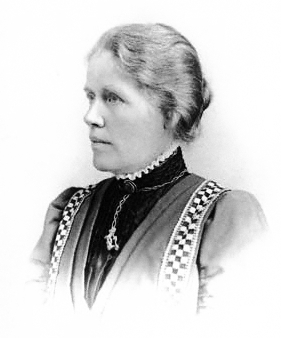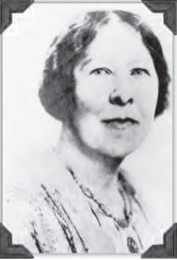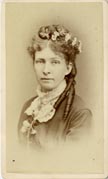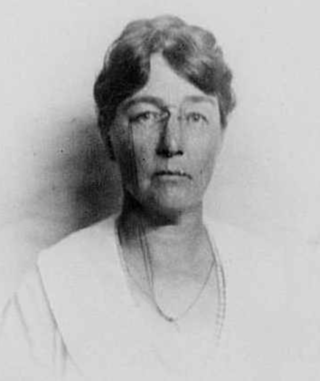Related Research Articles

Matilda Smith (1854–1926) was a botanical artist whose work appeared in Curtis's Botanical Magazine for over forty years. She became the first artist to depict New Zealand's flora in depth, the first official artist of the Royal Botanic Gardens at Kew, and the second woman to become an associate of the Linnaean Society. The standard author abbreviation M.Sm. is used to indicate this person as the author when citing a botanical name.

Harriet Margaret Louisa BolusnéeKensit was a South African botanist and taxonomist, and the longtime curator of the Bolus Herbarium, from 1903. Bolus also has the legacy of authoring more land plant species than any other female scientist, in total naming 1,494 species.

Mary Katharine Brandegee was an American botanist known for her comprehensive studies of flora in California.

Anne Elizabeth Ball (1808–1872) was an Irish botanist, amateur algologist, and botanical illustrator. Born in Cobh 1808, Ball was a sister of naturalist Robert Ball and zoologist Mary Ball (1812–1898). The siblings became interested in natural history through the passion of their father, Bob Stawell Ball.

Nellie Adalesa Brown (1876–1956) was an American botanist and government researcher. Much of her research focused on plant pathology. While working with Charles Orrin Townsend and Agnes J. Quirk as assistants for Erwin Frink Smith, Brown and her colleagues described Agrobacterium tumefaciens, the organism responsible for crown gall in 1907. They also identified methods of mitigation.

Margaret Jane Benson was an English botanist specialising in paleobotany, and one of the first female members of the Linnean Society of London. Most of her career was spent as the head of the Department of Botany at Royal Holloway College, University of London from 1893 to 1922. In 1927, a botanical laboratory was dedicated in her name. She travelled extensively with Ethel Sargant, collecting specimens, laboratory equipment, and meeting other botanists around the world. Her students included Dame Helen Gwynne-Vaughan, Theodora Lisle Prankerd, Nesta Ferguson, and Emily Mary Berridge.
Suzanne Célina Marie Julie JoséphineLeclercq was a Belgian paleobotanist and paleontologist known for her study of Devonian period plants.
Anna Vickers was a marine algologist and plant collector known principally for her work on algae of the Antilles and the Canary Islands.
Elizabeth Andrew Warren was a Cornish botanist and marine algologist who spent most of her career collecting along the southern coast of Cornwall. Her goal was to create a herbarium of indigenous plants of Cornwall, and to this end she organized a network of plant collectors for the Royal Horticultural Society of Cornwall and provided numerous specimens to William Hooker at Kew Gardens for his study of British flora.

Alicia Margaret Tyssen Amherst, Baroness Rockley was an English horticulturist, botanist, and author of the first scholarly account of English gardening history.
Mary Alice Eleanor Richards (1885–1977) was a British botanist.
Lumina Cotton Riddle (1871–1939) was an American botanist. She was a direct descendant of John Cotton.
Tatiana Krasnoselskaia was a botanist specializing in plant physiology from the Russian Empire and later the Soviet Union.
Frjeda Blanchard, née Cobb, was an American plant and animal geneticist, the first to demonstrate Mendelian inheritance in reptiles.

Mary Ellen Pulsifer Ames (1845-1902) was an American botanist. Along with Rebecca Merritt Austin and her daughter Mrs. Charles C. Bruce, Ames is credited with helping establish "the foundation to our knowledge of the vegetation" of northeastern California. She also recorded meteorological data for the Smithsonian Institution.
Emilia Frances Noel was a British botanist, author, and illustrator.
Marian Muriel Whiting was a British horticulturalist and plant collector, notable for collecting plants from Hong Kong and Guangzhou. She was born in London and spent a portion of her childhood in Hong Kong before studying at London University. Over 600 of her specimens were donated to the Kew Botanical Gardens. In 1940, she became a Fellow of the Linnean Society of London, and volunteered at Kew for many years. The standard author abbreviation Whiting is used to indicate this person as the author when citing a botanical name.
Julia Warner Snow was an American botanist and was known in the scientific community for her work as a systematic phycologist.
Isobel Agnes Arbuthnot (1870–1963) was an Irish-born botanist and botanical collector based in South Africa.

Caroline Thomas Rumbold was an American botanist. She specialized in forest pathology. Her researches focused on “fungus diseases of trees and blue stain of wood.”
References
- ↑ "Thirteenth Annual Report of the Director". Missouri Botanical Garden Annual Report. 1902: 22. 1902. doi:10.2307/2400120. JSTOR 2400120.
- ↑ Joy Harvey and Marilyn Ogilvie (1 January 2000). "Eva M. Reed". In Marilyn Ogilvie; Joy Harvey (eds.). The Biographical Dictionary of Women in Science. Vol. 2. New York and London: Routledge. p. 1083. ISBN 978-0-415-92040-7.